In June 2023, New England Forestry Foundation (NEFF) and Dirigible Brewing Company entered into a unique partnership to demonstrate the workings and benefits of a small-scale bioeconomy, or one that runs on materials and services derived from renewable biological resources like plants.
The organizations, both headquartered in Littleton, Massachusetts, organized a Red Spruce tip harvest at Lincoln Davis Memorial Forest—NEFF’s first forest since its founding in 1944—to brew a special Spruce tip beer that would embody and showcase a true taste of New England. The story below highlights the characteristics and regional importance of the Red Spruce tree, the sustainable harvesting of new tip growth, and the careful brewing process that made this project a joint success.
Everyone at NEFF would like to thank Dirigible for their support, as $1 from each spruce-tipped beer the company sold went directly to NEFF’s conservation efforts.
Finding
Knowing where to find Red Spruce trees is easy; they prefer the cool boreal forests to which we hardened New Englanders are accustomed. From the northernmost parts of Maine down through the Berkshire and Taconic ranges into northwestern Connecticut, the Red Spruce grows in relatively poor or thin soils to an average height of 60–75 feet. Shade tolerant, though it desires full sun exposure, it can survive and out-compete other tree species underneath the forest canopy.
Red Spruce is the dominant tree used for lumber and pulp across much of Maine. Because of its superior tonal quality, musical stringed instruments are another, though lesser known, byproduct of timber harvests. For hundreds of years, Red Spruce sap was chewed as a type of gum. The tips, in particular, were prized for their vitamin C content. First used in teas, it wasn’t until the mid-to-late eighteenth century that spruce tips were commonly added to beer to prevent scurvy. The boozy beverage is famously referenced in Jane Austen’s 1815 novel Emma and credited in Captain James Cook’s personal account of his 1784 voyage to the Pacific with saving all but two “invalids.”
It is for this latter use NEFF and Dirigible staff members find ourselves in the Wapack range of southern New Hampshire on June 21. Not to stave off scurvy to save our nine-person convoy, though the journey at times does prove mildly treacherous. Today, we are here to brew beer. More specifically, we are here to pick spruce tips so we can then make spruce tip beer. This is not the early medicinal version, but the modern craft beer version—a bespoke small-batch offering that is big on flavor and novelty.
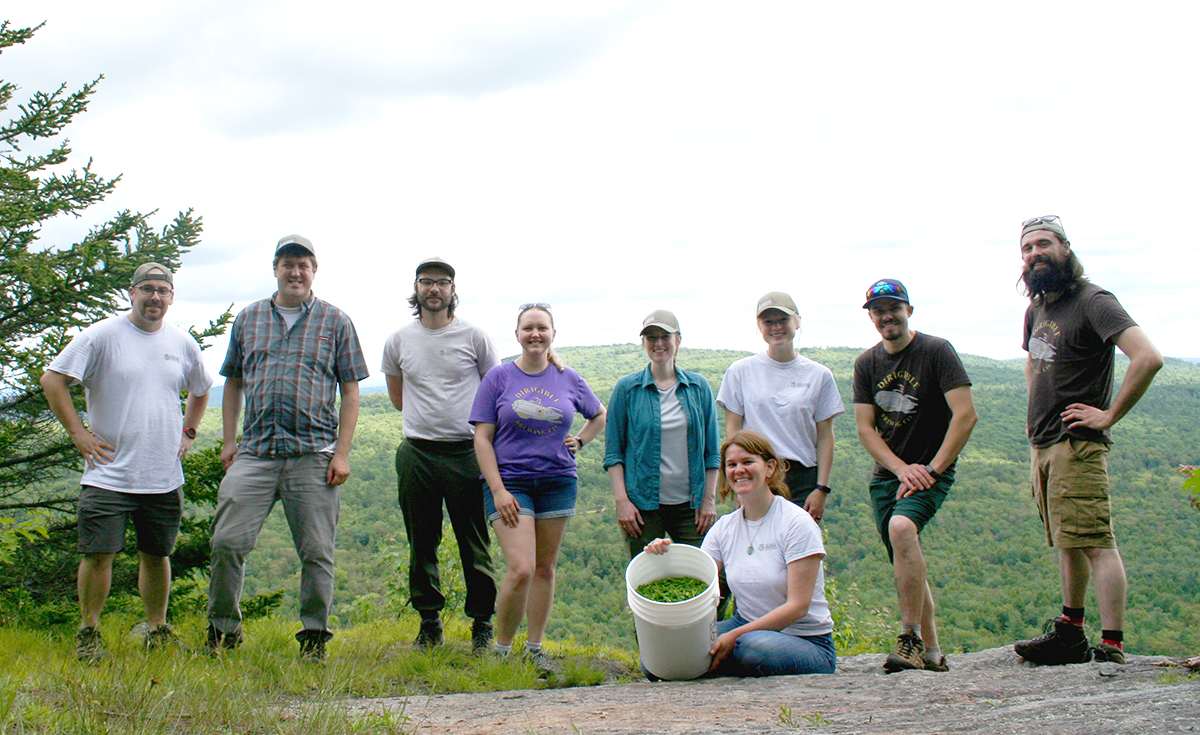
The nine-person convoy, from left to right: David Ayers, NEFF Development Communications Specialist; Andrew Bentley, NEFF Conservation Easement Director; Corey Wrinn, NEFF Stewardship Associate; Lindsay Sherman, NEFF Development Associate; Jennifer Shakun, NEFF Bioeconomy Initiative Director; Meaghan Guyader (seated), NEFF Executive Assistant; Sophie Anthony, NEFF Conservation Project Manager; Colin Knirk, Dirigible Brewing Company Co-owner and Head Brewer; Chris Loring, Dirigible Brewing Company CEO, Co-owner, and Taproom Manager. Photo: David Ayers
As a group, our collective knowledge spans a wide range of subjects. There’s a licensed forester and bioeconomy initiative director, a conservation easement director, a stewardship associate, a conservation project manager, a development communications specialist, a development associate, an executive assistant with a Ph.D. in civil and environmental engineering, and two brewery co-owners who assume a variety of roles inherent of a small business. If you’re waiting for a punchline, there isn’t one.
It’s interesting, though not unusual, to find the lot of us here. As a people, we’ve long foraged for our food. In the wake of COVID victory gardens, this seems like a regression to our roots. In a way, that’s the reason we’re here: to illustrate our relationship with nature, a sustainable model of give and take that highlights the partnership between plants and humans that have existed for millennia. NEFF teaming up with the Dirigible Brewing Company is a twist on the popular “farm-to-table” concept, a communal gathering neither extraordinary nor new.
This land we walk is special. It happens to be NEFF’s first forest, and began as a 607-acre parcel deeded to the foundation by Dr. Lincoln Davis in 1945. The Lincoln Davis Memorial Forest, as it came to be called, is currently managed with NEFF’s in-house forest management approach, Exemplary Forestry. Exemplary Forestry is the highest standard of sustainability currently available to the region’s forest owners for three key goals: enhancing the role forests can play to mitigate climate change, improving wildlife habitat and biodiversity, and growing and harvesting more sustainably produced wood.
The forest, now named the Lincoln Davis-Cabot-Morse Memorial Forest in recognition of 322 acres of later land donations—bringing the total property to 929 acres—is abutted my multiple easements held by NEFF, which when combined with the Memorial Forest create an uninterrupted 1,497-acre block of conserved land. With Temple Mountain State Reservation, Miller State Park, and Wapack National Wildlife Refuge to the north, the stitching together of these NEFF parcels protects a sizable portion of the 21.5-mile Wapack Trail, which traverses the ridgeline between Mt. Watatic in Massachusetts and North Pack Monadnock in New Hampshire. In addition to recreation, this is an important corridor for wildlife. In the winter, animals such as deer and moose can be found huddled under the low-hanging branches of the Red Spruce, which they rely on for protection against the elements.
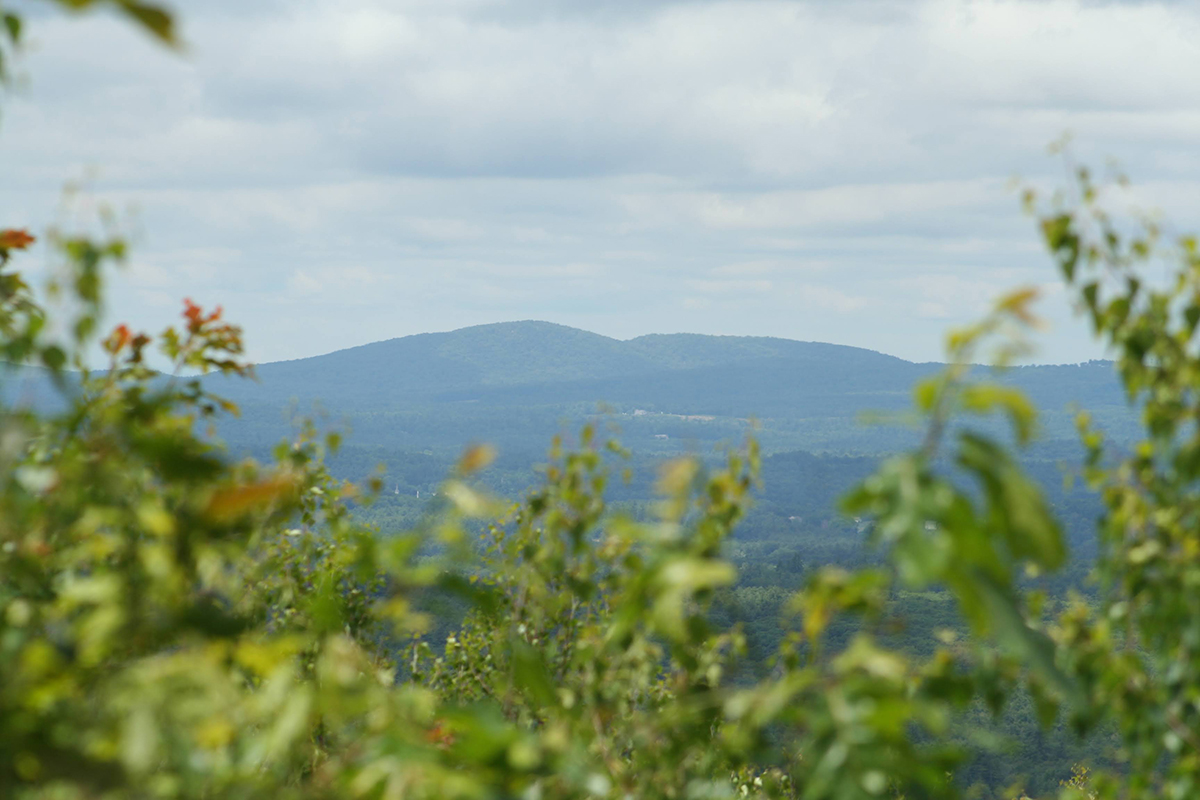
A view to the north is visible through the canopy on Lincoln Davis’ Berry Pasture Trail in Sharon, NH. Photo: David Ayers
Timing
Unlike finding Red Spruce trees, timing a spruce tip harvest is surprisingly difficult. New buds typically appear in the last weeks of spring. In New England, spring is an ambiguous period not marked by the Gregorian calendar. It is dictated instead by the weather, which, in this area of the country, is highly unpredictable. As such, there is a small window to forage for new-growth tips, especially the ones we’re looking for. Early flowering buds—neon green in color and roughly a half-inch in length—are best for aromatics and taste. If picked at exactly the right time, the tips impart a sweet, citrusy profile similar to hops. A week or two later, they’re greenish-brown and earthy.
Complicating things further is the Balsam Fir, also common in these parts. To the untrained eye, Balsam Fir can easily be mistaken for Red Spruce. Although the trees may look alike, Red Spruce’s sharp needles are round enough to spin between one’s thumb and index finger. Balsam Fir’s needles, however, are noticeably flat when handled. In addition, Balsam Fir new growth happens earlier in the spring.
Finally, buoyed between weeks of rain, the team was fortuitous to strike a break in weather suitable for a harvest. It just so happened to be the Summer Solstice as well. With the sun shining brightly we would have all the natural light we could wish for. This was not an original consideration for our choice of day, but a serendipitous occurrence as we would soon realize.
Harvesting
Harvesting is hard work. Harvesting sustainably and respectfully is harder yet. This is not a complaint; it is a statement of fact. The picking itself, though laborious and time-consuming, is the easy part. Deciding which tips to pick from which trees is the challenge. It is true we need to be discerning about the tips we choose since it directly affects the end product. It is also true we need to consider our impact on the environment in being equally selective of the tips we harvest. It’s a delicate balance to strike, requiring foresight, knowledge, and mindfulness. Harvesting thoughtfully is far more nuanced than most realize.
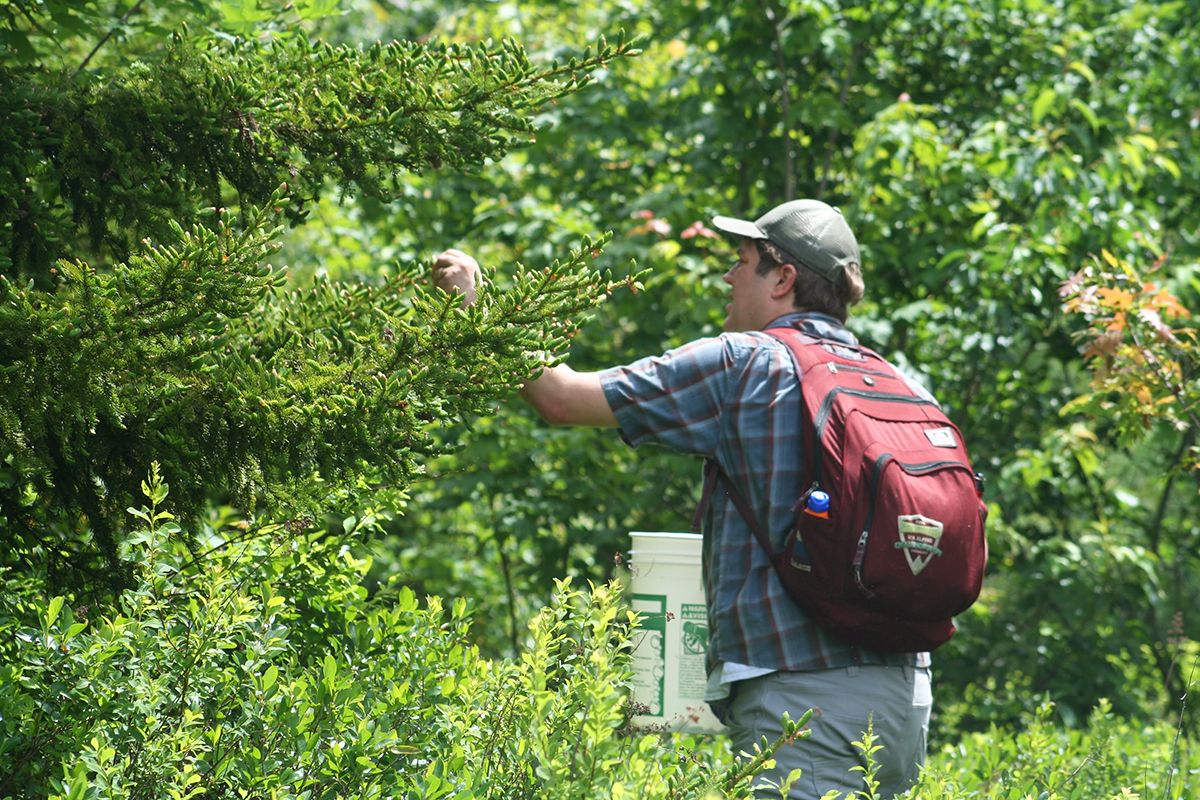
NEFF Conservation Easement Director Andrew Bentley examines new growth at the base of a mature 50-foot Red Spruce basking in Berry Pasture Trail’s open field. Photo: David Ayers
Interestingly, this is not unlike the working forestlands that supply the wood products our society needs and relies on. As much as it may seem an art, harvesting is simultaneously a science. There is an emotional component, an attachment to the land that demonstrates reverence for the abundance that nature provides. But there is also a logical component, an analytical lens rooted in science that helps guide our actions. We know that what we do and what we leave behind has profound implications for the future.
In forestry, with its different silvicultural management practices, we consider the health of the forest and its trees, the growth and succession of species, the rate of regeneration, and the benefit of woodlands for wildlife and humankind. We’re keen to acknowledge the long history of land management well before European colonization and the aftermath of the uncontrolled and indiscriminate harvesting that followed. We take seriously the trust placed in us. Being stewards of the Earth is a responsibility not taken lightly.
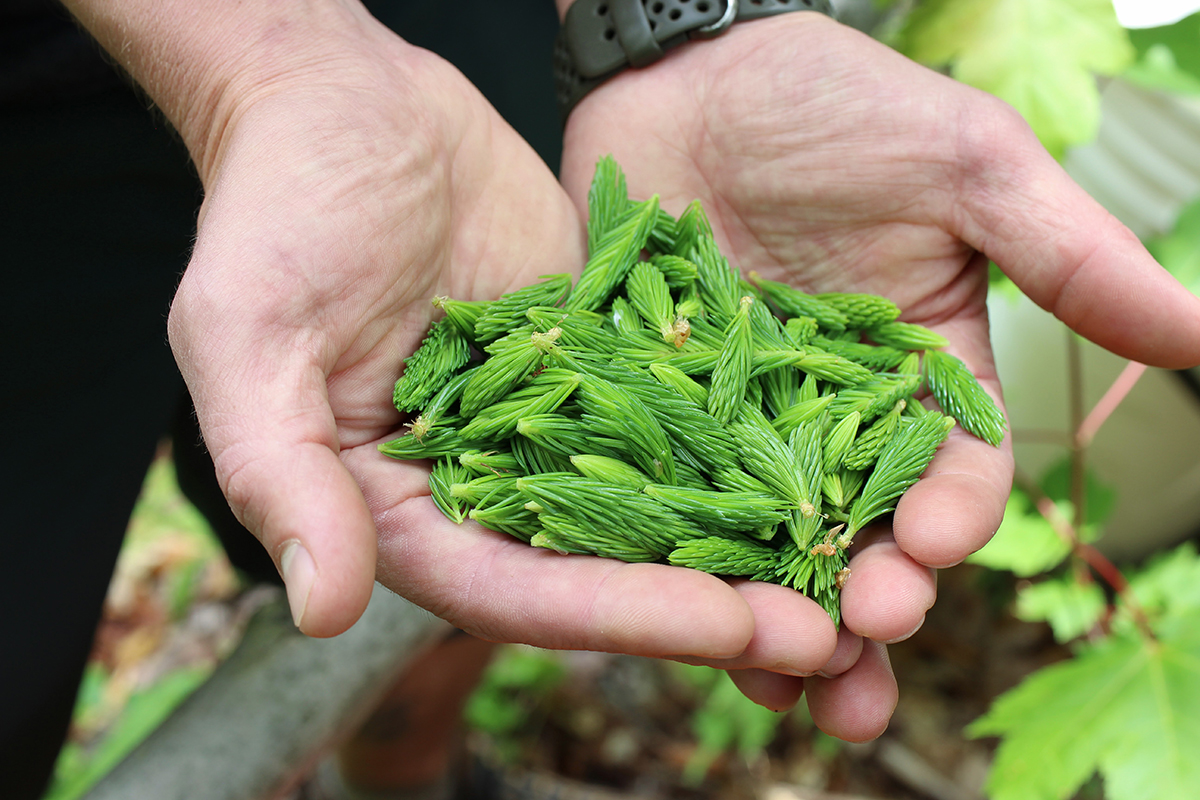
Handled with care: Dirigible Brewing Company Co-owner and Head Brewer Colin Knirk cradles a batch of the young, just harvested Red Spruce tips. Photo: Lindsay Sherman
In a bioeconomy, forests are one of the largest nature-based solutions for mitigating climate change. The use of wood and engineered wood materials in buildings, especially, provides carbon savings few current solutions can rival. The production of timber for building construction is far less carbon-intensive than the processes that make steel and concrete for similar purposes, and wood continues to store carbon long after it’s been harvested. In terms of circularity and sustainability, it matters to know where our products come from, what materials are used, how the materials were sourced, the associated carbon emissions, and the product’s longevity and repairability. We need to become more intimately familiar with our personal footprint, and our own consumer behavior. Trees are remarkably resilient and they’re renewable. With NEFF’s Exemplary Forestry approach to forest management, we can meet our goals of building a better tomorrow by working with the natural world.
Brewing
If patience were an ingredient in beer, it’d be the binding agent from which all flavor is derived. In fact, without patience, it is doubtful one would have beer at all. Maybe a sweet malt tea or a mealy barley oatmeal, but nothing resembling the tasty combination of water, hops, barley, and yeast with which we are familiar.
This is a literal interpretation, of course, since beer must ferment. Fermentation is one part—the final part—of the brewing process by which yeast converts the sugars in the wort to ethyl alcohol and carbon dioxide gas, giving beer its alcohol content and carbonation. This can be a weeks-long process. But it’s also a metaphor, an important human quality in this case, that guides tweaking and troubleshooting. Patience, today, on the spruce tip beer’s brew day, is in ample supply. The wort, while it isn’t supposed to be completely clear based on the protein content in the spelt, also shouldn’t look like “coffee-milk,” so I’m told.
“We’ll need to recirculate [the wort] and bring it up to temperature, so the converted starches are converted to sugars,” says Chris Loring, Dirigible Brewing Company CEO, Co-owner, and Taproom Manager.
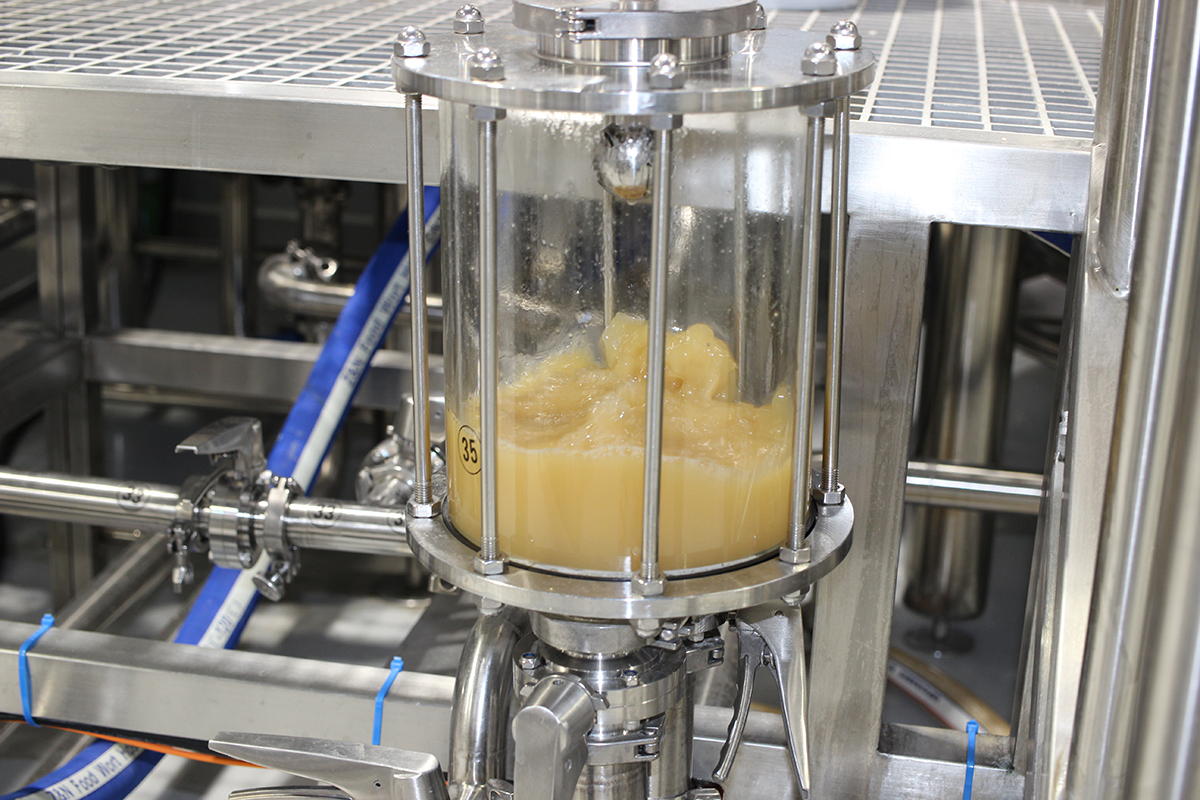
Wort from the first iteration of NEFF and Dirigible’s spruce tip beer, “All Spruced Up.” Photo: Lindsay Sherman
Dirigible’s Co-owner and Head Brewer Colin Knirk suspects an issue with the calibration of the mash tun. This is a thing of firsts, apparently, since the machine hasn’t needed to be calibrated at all since it was installed a year ago. Chris deduces there are also trapped pockets of heat in the wort, which suppressed the temperature. He breaks up the thick grain bed with a homemade wooden mash paddle so the rakes in the mash tun can spin freely.
As a guest of the brewery today, I get a behind-the-scenes look into the brewing process. There are levers, pipes controlled by levers, electronic systems controlling temperatures, and lots of really shiny metal. The space is a foreign and maze-like one, with gadgets everywhere. It’s as clean and bright as you would envision a laboratory to be—a beer laboratory.
Colin and Chris maneuver through the different stations with ease. I imagine they could navigate the brewhouse in complete darkness if they needed to. It must feel like a second home to them. Even in their flow state they can sense my confusion. They toss me a reference to which I can better relate: baking. The process of brewing beer is similar to baking and baking exclusively.
“Cooking is forgivable; you can make it work,” says Colin. “Baking is more of an exact science.”
As we walk around, I’m told that a couple of the brewery’s suppliers are based right here in Massachusetts—Stone Path in Wareham and Valley Malt in Holyoke. This is notable for a couple of reasons: first, it’s one local business supporting two others; second, the proximity of the suppliers to the brewery cuts down significantly on transportation carbon emissions.
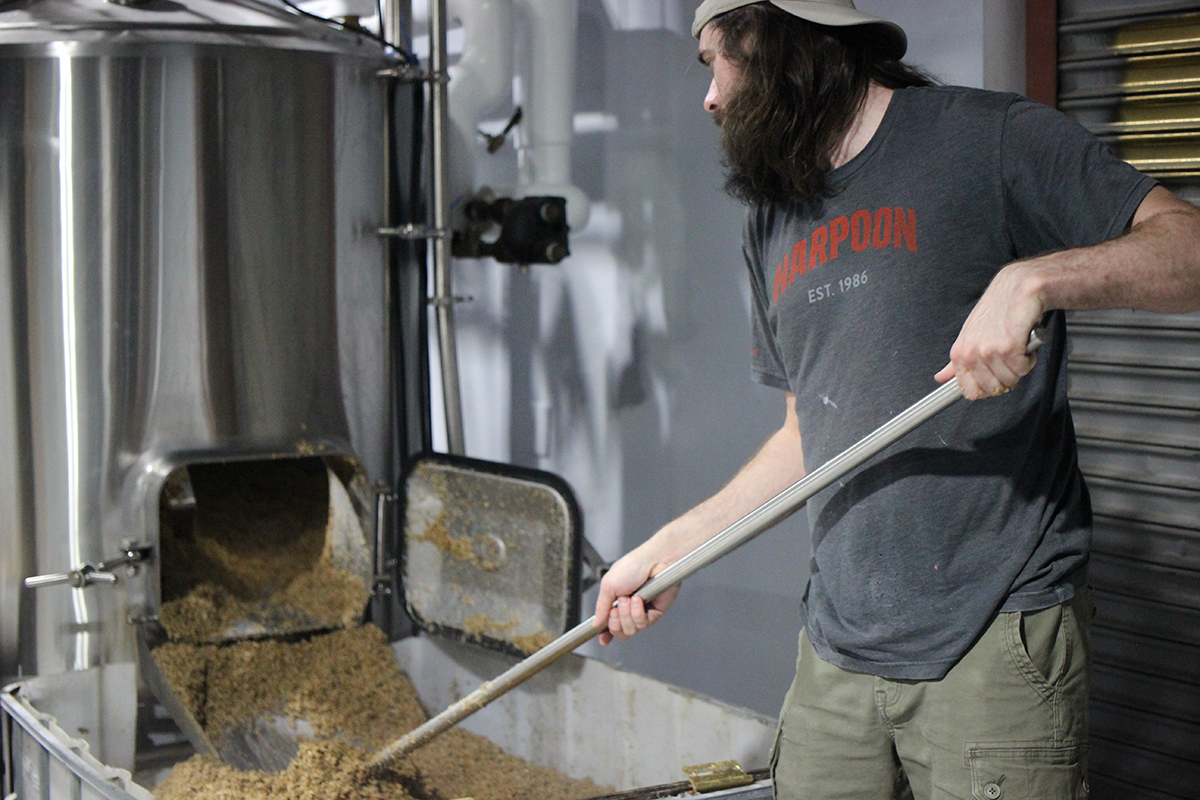
Dirigible Brewing Company CEO, Co-owner, and Taproom Manager Chris Loring removes spent grain from the brewery’s mash tun. Photo: Lindsay Sherman
That’s not Dirigible’s only sustainable practice. For instance, Dirigible saves and packs the spent grain following the mashing process for a local dairy farm. Instead of a form of waste, this byproduct is used anew for animal feed. It’s an amazing local collaboration mimicking a closed-loop food system. I’m reminded of similarities with the wood industry, and of TimberHP in particular, an American company that takes wood chips left over from lumber production and converts them into energy-efficient wood fiber insulation for use in homes.
Dirigible, I hear from a well-informed regular, also made a significant investment in the brewery’s state-of-the-art exhaust system that helps minimize emissions from the brewhouse. I’m not surprised to hear this from a third-party source. Colin and Chris are modest and hard-working. They don’t seek recognition. They also strictly avoid cutting corners.

Moment of truth: Dirigible Brewing Company Co-owner and Head Brewer Colin Knirk readies the first bag of Red Spruce tips during the hopping phase. Photo: Lindsay Sherman
I’m eager to witness the introduction of the spruce tips during the two-part process of hopping and whirlpooling—NEFF’s contribution, finally. Three netted bags are set aside for steeping: one five-pound bag at 10 minutes to the end of boil; one five-pound bag at 5 minutes to the end of boil; and one ten-pound bag at the last steep. The entire boil time is 60 minutes.
“Introducing the tips at different times has different effects,” says Colin. “The longer you boil [the tips] the more you get rid of those aromatics as vapors.”
The smell is hypnotizing. Patience, here, has been duly rewarded. We know immediately the beer is sure to please.


